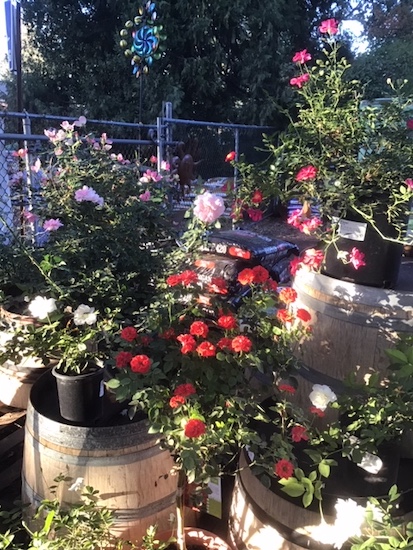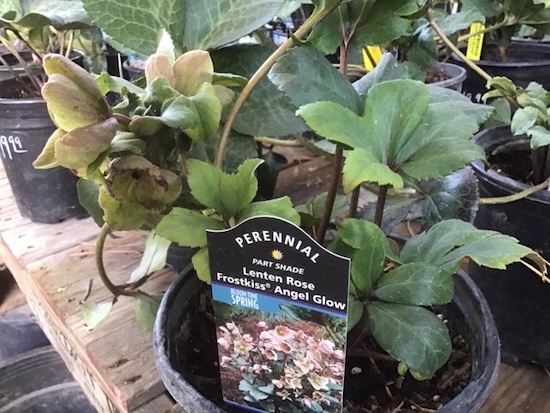Nov 2020 News
Winter Hours Begin Nov 1, 10-4, 7 days a week.
Closed Nov 25 and 26

Here we are in the last week of October, and although the National Weather Service did put out a freeze warning for us, it failed to materialize. However, I did get a response from a customer who got down to 29 degrees the morning I posted on Facebook about it. You never know for sure. Now it’s unseasonably warm and worse yet still dry. I was actually beginning to think Middletown had made it through this year without a PSPS, but it was not to be. If we do not get rain, we are going to have more power shut-offs. We do not run a generator full time, so even though we are open, please remember to bring cash or check to purchase during shutoffs. Water your pots and landscape before the shut off because your electric irrigation valves will not come on. If you do not have a battery to hold the correct time and your run program, you might find yourself all off on your start and run times. Here at the nursery, we usually have to re-prime our pressure tank on our well/storage tank to get the water back on.
If you do not follow us on Facebook, then you missed the post about time to think about protecting your cold-sensitive plants. Some of us like to put our houseplants outside on the shaded porch in the summer because, just like us, they like to get outside in some fresh air. Once those nighttime temps hit 40, they are not going to be so happy. Bring them in before it’s too late. Do you have plants that need frost cloth protection like citrus? It is probably a little early to cover as no frost is expected this week, but that could change. Make sure you are prepared and have your frost protection on hand. Our favorite is the N-Sulate available at the nursery. A 10×12 piece costs 14.99, and you can cut it smaller. Most of the citrus trees we sell can take temps to 27 and even lower but not the fruit or flowers. You need to keep those from frost/freeze. Battery operated timers are to be removed and brought inside when the night temps drop below freezing. Hopefully, we will get rain, and you can shut off the irrigation entirely and drain your irrigation valves, so they do not crack from water freezing inside.

We are asked a lot about how often you should water the plants you are buying and planting now. If it was summer, I would say, every day, no problem. This time of year, it is harder for us to answer that as a lot of the plants are heading into dormancy and are not actively growing other than rooting out in the soil still warm from the summer. My best guess is 3 times a week or every other day for trees and shrubs for the first couple of weeks. After that, if we get no rain at least once a week if not twice, depending on how warm or windy it is. Hydrated plants withstand winter cold snaps much better than dry plants. Small cool-season vegetable and annual starts in the sun will need it every day for the first couple weeks after planting for sure unless it is obvious the soil is still damp, and they show no signs of wilting. They are actively growing this time of year.
Do you have hydrangeas that you are hoping to keep blue? November is the time to apply GreenAll True Blue. This acidifies the soil, which is what turns the flowers blue. Next years flowers actually start forming now in the old wood as those side buds start to swell. Make sure you or your gardener does not cut those hydrangeas back hard, just down to the second buds from the top, or you will be very disappointed next year. It’s not too late to sprinkle out wildflower seed. Time to get those bulbs in the ground. We are out of red onions but still have yellow and white, plus garlic. Seed potatoes are due this month. Plenty of daffodils, iris, and tulips left to get planted now. We have a good selection of winter vegetables, and if you love pansies, the best selection of the year is now.

Are you new to growing fruit trees? It is recommended that you dormant spray with horticultural oil for overwintering insect eggs and a fungicide like copper or sulfur for overwintering fungus and bacteria. Best to apply three times while the trees are dormant. The schedule goes once in November, again around New Years, and a third in February. Please try to do it at least once, and if you have peaches and nectarines, apply the fungicide again at 2/3rds flower petal drop in the spring. This is the best timing to try to control a disease called Peach Leaf Curl. If we have a wet spring, this disease can cause total defoliation of your tree. These are all approved sprays for organic growing.
This has been a very busy year at the nursery, and we are continuing to do re-ordering even though it is late in the year. We just received more smaller sized terra cotta pots, and some of the larger sized standard pots are on order. 2021 liner pots of figs, blueberries, cane berries, some grapes, pomegranates, and olives usually come in November. Bare root trees come in January. Bare root roses around the first of February. We just placed our spring seed order and went double and triple on some of the numbers to stock up as opposed to relying on being able to re-order. Those cute pot hangers are here for smaller gift ideas. VF11 is back in stock for now. Looking to make your own compost? We just stocked a couple of drum composters. I am trying one at my house. How about compost tea? A local supplier of LLama Poo, Stonehouse Grown, just approached us about her product. LLama ‘beans’ will not burn, are a balanced fertilizer, and you can apply directly to all your plants, including house plants. Make a brew by steeping a cup of beans in a gallon of water and apply as a foliar spray. Add some to your compost pile to introduce beneficial goodies. These are packaged in rustic burlap, and we think could make great gifts.
Christmas Trees-Potted living Oregon grown conifers come around the middle of the month for those of you who want to plant a tree as opposed to tossing one. For the rest of you, the plan is to have the cut trees available the day after Thanksgiving. The bad news is we were unable to get the larger sizes (over 8 ft), and we will basically have Nordmanns and Dougs, no Nobles. Still, we usually sell down or out by the second weekend in December, so don’t wait till the last minute.

House plants have been super popular, but with the cold coming on, it’s time for us to sell down our stock. One of the most memorable gifts from my father, as I was growing up, was a houseplant. It was a Sanseveria that I had the whole time I was growing up. We are putting them on special this month along with Succulents, Yuccas, 2020 deciduous Fruit Trees, Roses, Glazed Pots, Iron/Metal, and Hellebores. Early holiday shopping?
November Specials
20% Off
- 2020 Roses and deciduous fruit trees
- Iron and Metal Art, Benches and Arches
- Glazed Pottery
- Houseplants
- Succulents, Yuccas, and Agaves
- Hellebores
Plant of the Month
Helleborus Hybrids

Many of you are probably not familiar with these distinctive, long-lived, deer resistant, winter-blooming perennials, but we are hoping to change that by featuring them this month. Readily available this month are a selection of hybrids that are most similar to Helleborus orientalis from Greece, Turkey, and Caucasus. The common name is Lenten Rose. Another variety, Helleborus niger is called the Christmas Rose. The leaves are very leathery and five-lobed, attractive on their own. The flowers are bell or cupped shaped, often facing downward, Hybridizers are working on getting the flowers to face up so some of the newer introductions do just that. Flowers are often speckled, very long-lived, and in the past were white or light pink but new hybrids can even come in reds and dark purples now. They all fade to green at the end. They make good cut flowers if you slice the stem lengthwise or you can float them in water.
Hellebores actually prefer slightly alkaline soils like Daphne, but most kinds will take slightly acid soils also. Plant them in full to partial shade. Plant in well-drained soil with plenty of organic matter. They like moderate to regular water but since they are dormant in the summer months I consider them fairly drought-resistant. Feed once or twice a year. Do not try to move them once established. They often struggle after you do. Warning: All parts of this plant are poisonous if ingested so if you have a small child or plant-eating pet you will want to keep this away from them.